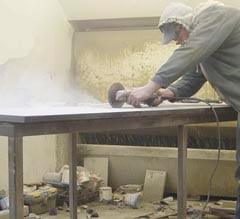£90,000 HAVS fine plus £45,000 costs should be a deterrent
The cost of ignoring the damage that vibration can cause to employees using power tools is increasing. And companies that ignore the risks are more likely to get prosecuted.
The latest prosecution was on 25 March at Stoke-on-Trent Crown Court. The company prosecuted was not a stone company but Faiveley Transport Tamworth Ltd of Graycar Business Park, Burton on Trent, Staffordshire, a train refurbishment company.
Stoke-on-Trent Crown Court heard how Faiveley Transport Tamworth exposed its workers to uncontrolled and unrestrained exposure to vibrating tools from 2005 to 2015 at its Amington site in Tamworth. Company employees used various vibrating tools, including sanders and air-fed cutting equipment, to refurbish train doors.
In 2015, one of the people employed there raised concerns regarding symptoms of HAVS (hand arm vibration syndrome) as a result of exposure to the air-fed cutting tool he was using to remove rubber seals from train doors.
Despite the company being made aware of this, it failed to take prompt action to manage the risk. Later, another member of staff reported that he used grinders up to eight hours a day, often until his hands hurt.
An investigation by the Health & Safety Executive (HSE) found Faiveley Transport Tamworth had failed to consider the risk to both its employees and agency workers of exposure to hand transmitted vibration (HTV) over a prolonged period of time.
The investigation found that there was little or no oversight by management to control exposure to vibrating equipment and there was an absence of a safe system of working, including control, monitoring and maintenance measures.
The investigation also found measures to conduct a suitable and sufficient risk assessment of that exposure were not taken, instruction and training on tool use was not provided, and the company did not have health surveillance in place.
Faiveley Transport Tamworth Ltd pleaded guilty to breaching Section 2 of the Health & Safety at Work etc Act 1974. It was fined £90,000 and ordered to pay costs of £45,000.
Speaking after the hearing, HSE inspector Theresa Hewkin said: “This was a case of the company completely failing to grasp the importance of HAVS health surveillance.
“If the company had understood why health surveillance was necessary, it would not only have ensured that it had the right systems in place to monitor workers’ health but would have identified from the outset that one of their employees has primary Raynaud’s phenomenon and should not have been made to work with vibrating tools because of his likely heightened susceptibility.”

